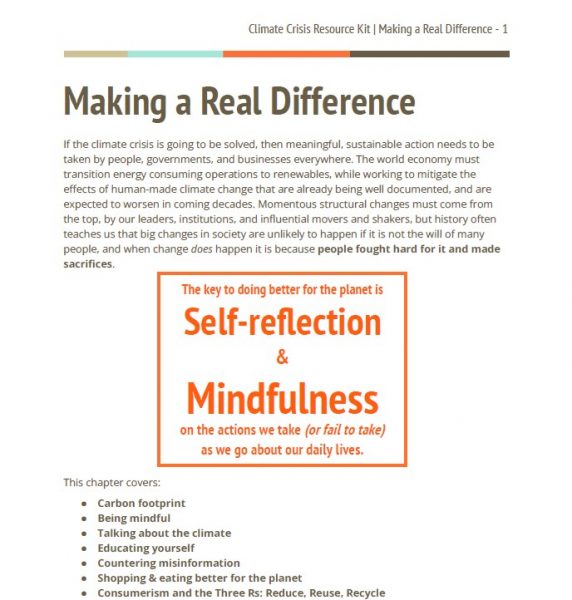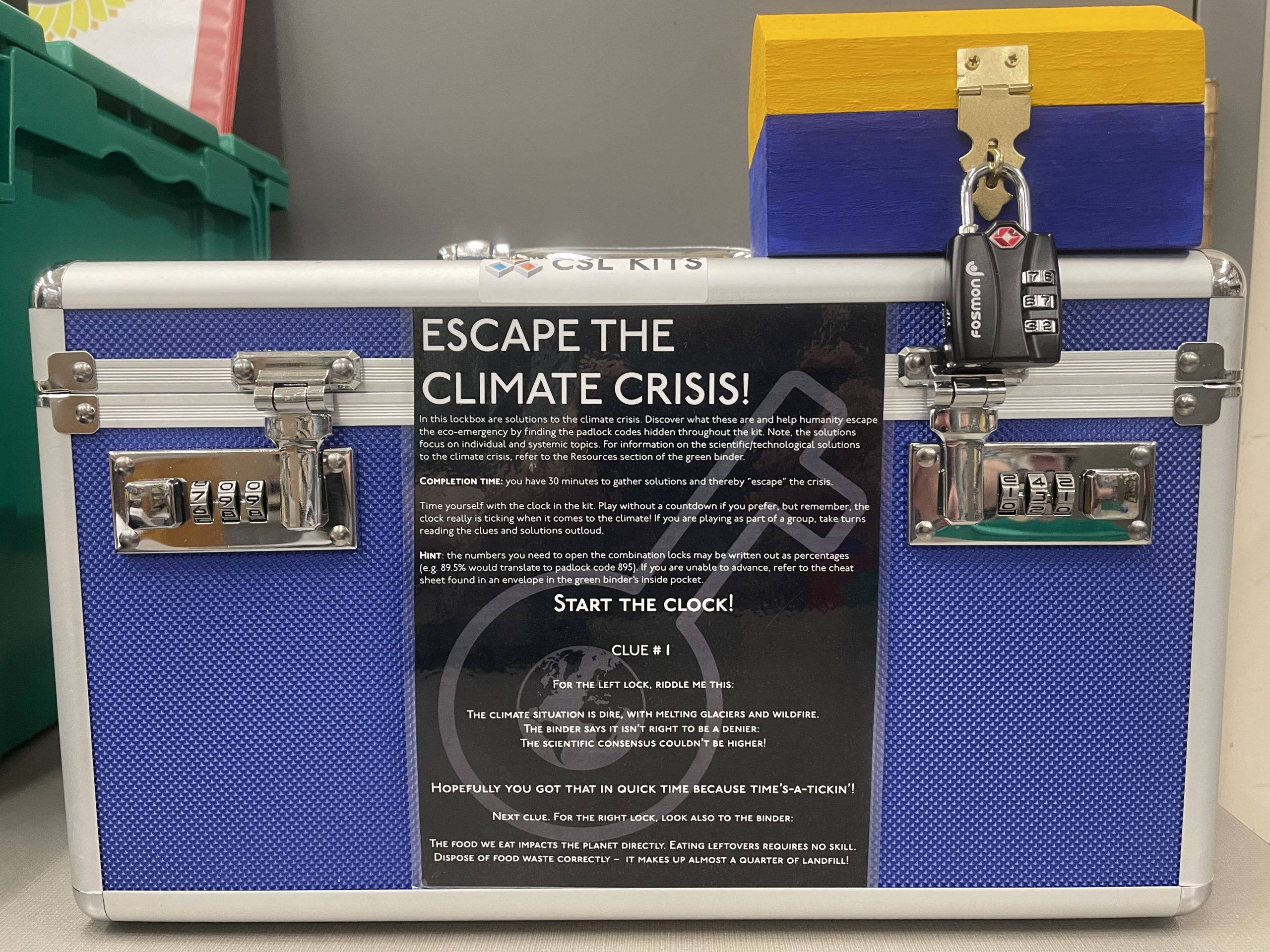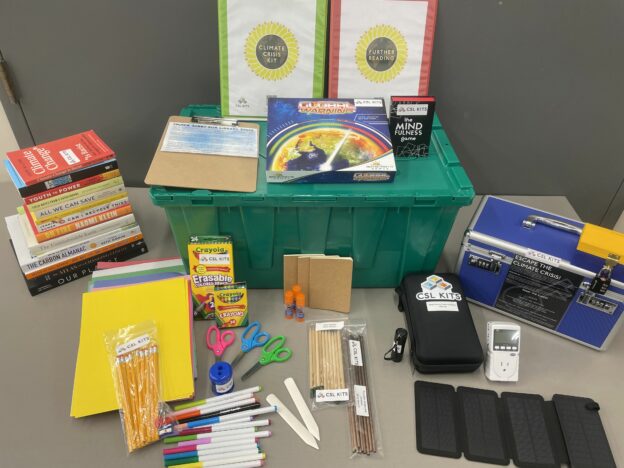Stories about climate change are going to come from conversations we have with friends, family, and colleagues — we need to all become multipliers of this message. And in order to do so, we need to think deeply about this issue and understand how it will affect us. So we need to think critically about what kind of story we are telling. Are we telling a story of despair and so-called inevitability? Are we telling a story about negative emissions, feedback loops, tipping points, or other things most people don’t understand at all? Or are we telling a story of hope, possibility, and human agency? More importantly, are we making it clear when we talk about this that there are choices that we can make, which will determine what kind of future we are going to have. – Maria Virginia Olano, Climate XChange
The CSL Kits program recently launched a new addition to the collection – the Climate Crisis Kit. Let me be the first person to say it: this is a heavy kit (literally and figuratively), but don’t let that deter you! (Rest assured, thanks to rollie wheels on the container, the kit is easily transported.) The kit is filled with a wealth of information, resources, and engaging activities that will help bring the climate conversation to local libraries across the state.
The main purposes of the kit
- To provide libraries and other cultural heritage institutions across the state of Colorado with tools to facilitate community dialog on the climate crisis.
- To provide educational resources containing the scientific facts of what is happening to the global climate, what the root causes are, and what present-day conditions are contributing to human-made global heating.
- To combat feelings of powerlessness and “doom and gloom thinking” by providing positive guidance for making changes for the good of the environment and the ways in which institutions and individuals can take action by working together toward practicable solutions.

Background
I first came up with the idea for a social topics kit based on the climate shortly before the pandemic hit. The project stalled as staff time in the office became limited and I tried to figure out what has always seemed like a somewhat absurd task: create a set of genuinely useful materials on the climate crisis that will be continually transported to libraries across the state for in-person programming. There seemed to be something of a contradiction in the kit’s very idea. To avoid the kit ending up a total failure, it would, in the long run, need to somehow have a net positive impact in terms of emissions, or at the very least the good it does had to be enough to neutralize its emissions.
Such an undertaking (like climate mitigation itself, come to realize), would rely on everyday people and workers sensitive to their needs, such as librarians. People who have the agency to effect change in their communities, no matter how inconsequential a single individual’s impact may seem in the face of such a momentous task.
Doom and gloom thinking is one of our worst enemies
Sometimes, in the depths of pandemic and other catastrophic world affairs, it was painful to resume work on the climate kit. Head heavy with ever newer, ever more alarming headlines, the kit seemed to expand infinitely whenever I turned my attention to the progress made so far. The pandemic actually underscored our need to make improvements to our entire global infrastructure, but like most of us when it comes to climate change, I suffered with feelings of powerlessness and being overwhelmed. I needed to refine my approach to this kit, and the quote at the top of this article helped me see the light at the end of the tunnel.
I now have the firm belief that giving into doom and gloom thinking is just plain silly, as the scale of the climate crisis is still to be determined and mostly depends on how humans decide to behave right now and in the near future. I also came to realize that nothing makes a climate denier happier than hearing about how effective doom and gloom thinking can be.
The kit wasn’t going to solve the climate crisis (yet!), but it could have a small positive impact, and that in itself made it worth pouring my energies into. This, I now realize, is the correct approach when it comes to climate activism in general: if it has a positive impact, it’s worth doing, no matter how small. It matters. The same thought applies to the energy we use, the products we buy, the representatives, influencers, and leaders we support, and all the habits we cultivate.
Burnt-out people aren’t equipped to serve a burning planet … [so] the well-being of our hearts and souls must be reestablished to their rightful place as relevant, essential. – Susi Moser, All We Can Save, Published 2020
The way in which we think about a problem has the power to impact the problem itself, and this is especially true with the climate. All too often we only hear stories of doom and gloom from media outlets, instead of the thousands of ways that individuals and groups can and do make actual positive changes in the world. It is reasonable to ask: does the fear the media is creating improve our response to the climate crisis, or does it stymie people like myself who accept the magnitude of the problem, but feel nothing but paralysis? I know for myself, the negative feelings associated with the climate crisis made me avoid creating this kit for too long.
And if I was feeling it, I knew a lot of others were too. This avoidance, I knew, had to become a core focus of the kit.

Dialoging is essential for not giving into fear
In early 2020, the worrying state of the climate was already plain to see to anyone paying attention to the warnings of scientists across the planet. I was dismayed to read that only about a third of Coloradans were actually discussing this most pressing problem regularly, especially in light of increased wildfire, drought, and extreme weather in our home state.
Talking about a problem is the first step to tackling it. In most places in the industrialized world, we haven’t taken this crucial first step with any real gusto, yet people are also simultaneously tired of hearing about the climate.
This does not mean we should be debating the fact that human made global warming is happening and amounts to a crisis. The time for debating that is far past as scientific consensus was reached well over a decade ago (and that’s being generous). Most people accept that climate change is happening, and those that seek to obfuscate the truth do so usually out of vested interests or because their denial adheres to some ideology, neither of which can be easily circumvented in even the best debate.
The advice I have then is this: don’t debate. Instead, have positive, actionable, and practical conversations. Not just on or around Earth Day, but every day, and with anyone who will listen. I mean that sincerely, regardless of how annoying that might sound. If we don’t all collectively agree to talk about it (and thereby “multiply” the general population’s understanding), there is little chance we are going to reach a critical mass of buy-in from people, and that is exactly what is needed if we are ever going to bring global heating and the related ecological crises anywhere close to under control.
In all my research, I came to the clear conclusion that the climate crisis is indeed very scary, and that there’s good reason for it being termed a crisis. But we don’t have the luxury to give in to that fear. We must instead listen to that fear and use its energy to rethink absolutely everything we do.
Nonviolent conflict has been found to be successful in bringing about such large-scale social transformations if a critical mass of 3.5% or more of the population participates in the activism. In other words, if 11.5 million Americans march in the streets, there is a chance that this action would motivate some concessions from policymakers. Beyond responses to repressive and autocratic rule, though, there are very few examples of sustained activism at this level of engagement. Accordingly, it is unrealistic to imagine that this percentage of the United States, let alone the same percentage in numerous other countries, would mobilize and engage in peaceful climate activism without some sort of large-scale disaster as motivation. – Brookings
Dialog as a means to collective action
We should all be in agreement about protecting the planet (and by extension, people), regardless of our own personal beliefs. Sadly, we don’t have 100% agreement on all the issues, including how best to go about making the most change. But there is more attention being paid to this subject than ever before, with more young people (who will bear the burden of the effects of climate change) demanding better from world leaders.
Acting in concert with others, also known as climate activism (although it might more accurately be termed civic engagement), will give you courage and help to silence the inner fears that overwhelm too many of us. The kit does not endorse any one measure or form of civic engagement or activism, although neither does it shy away from discussing them. Instead, it contains ideas, suggestions, and resources with the overarching purpose of engaging local communities in a thoughtful way. The kit guides its users to put aside whatever preconceptions they hold and be willing to approach the topic in an open minded way, with calm, humility, and mindfulness.

We currently have two copies of the Climate Crisis Kit available for lending for two months. You can view the binder in full here, which includes a vast amount of resources, including clickable links (if you’d like to see what the deal is without even needing to request the actual kit!). See below to get signed up to our kits program.
We are also planning more kits to compliment this “core” kit, by exploring important themes related to climate, environment, and ecosystems.
How to Borrow the Kit
To borrow one of our kits, you need to be enrolled in the CSL Kits Borrowing Program. Your “Kit account” is the same as your CSL Book Club account if you participate in that program. If you already have a CSL Book Club user number and password, skip to step 4 below.
- Fill out and submit the enrollment form.
- You will receive an email with a user number and password for your library within a short time.
- Go to our online resource catalog at https://csl.catalog.aspencat.info/
- Login into your CSL account using the “Login” button at the top right of the screen.
- Use the Search bar, or browse for “Resource Kit” to find the Kit you want to borrow.
- Place a Hold on the desired kit.
- The checkout period is for two months.
- If the kit is available, it will be sent to you via the CLiC courier as soon as we are able.
- If it is checked out to another library, your hold will remain in place until the item is available or you cancel the hold.
- Kits are not available for loan to out-of-state libraries.
- Kits cannot be reserved for a specific date in the future.
- Note that kits are transported via the CLiC courier. It is possible to accommodate lending if your institution is not on the courier system but are able to pick the kit up from CSL.
Thanks
This kit would be nothing without the help of my State Library colleagues, in particular my team Director Regan Harper, who gave me the confidence to start this project, providing creative advice and invaluable help throughout. Huge thanks also goes to the Library Research Service’s Sara Wicen, whose background in environmental sciences and excellent writing and research skills brought incredible value to the final product (check out her recent LRS blog post on community resilience!).
They are testament to the fact that we can do much when we put our heads together.
- The Secret Lives of Book Club Sets - June 12, 2025
- Book Clubs Can Be Prideful - June 5, 2025
- Fast Facts – Kits and Book Club Sets - May 7, 2025